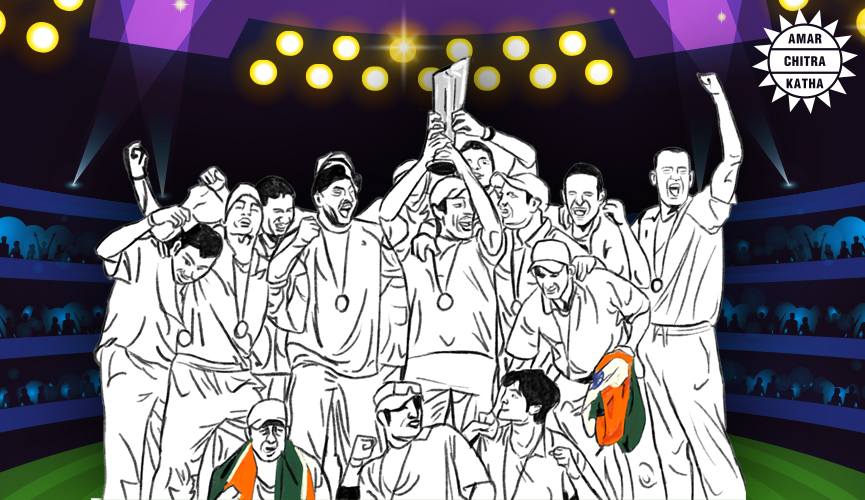India’s First Int’l T20 victory!
- September 20, 2020


India’s First Int’l T20 victory!
- September 20, 2020
By Samyukhtha Sunil

Indians have been playing cricket since the late 19th century. By 2006, India and the rest of the world were introduced to a brand-new format of cricket known as ‘twenty-twenty’ or T20 for short. It promised the audience more entertainment and power-packed matches that were reduced to 20 gripping overs instead of the more traditional formats of one-day internationals which consisted of 50 overs, or test matches that spanned over a few days. Indian audiences took to it like ducks to water, soon making India the largest consumers of the T20 format in the world! The Indian cricket team’s love for the format back to its very first season victory all the way back to 2007.
On December 1st, 2006, the Indian team marched into the Wanderers stadium in Johannesburg to take on South Africa in this brand-new form of cricket. With no experience in the format and no specific strategy in place, India took its chances against the opponent. Under the captaincy of Virender Sehwag, the players led the team to a slow-paced yet decisive victory. This day also marks the first and the only international T20 match to be played by the legendary cricketer, Sachin Tendulkar.
To receive more such stories in your Inbox & WhatsApp, Please share your Email and Mobile number.
With a new, young captain, Mahendra Singh Dhoni, taking over the reins of the team in the year 2007, India entered a glorious new era marked by massive victories and the revival of the Indian cricket team’s heydays. ICC launched its first edition of the international T20 world cup that year. The Men in Blue kickstarted the season by playing against newcomers Scotland. However, heavy rains wreaked havoc, bringing the match to an abrupt halt.
In the electrifying weeks that followed, India locked horns with different teams and won several matches. Amongst the most memorable ones was the match against Pakistan in 2007 in which legends such as Virendra Sehwag, Harbhajan Singh and Robin Uthappa swayed the team to a thrilling victory against the rival team!
It all finally boiled down to the play-offs when India was paired against Australia for the semi-finals. By now, the men in blue had gained a more definite hold on the format and had learnt the tricks of the trade. There was a tremendous shift in India’s playing form and its approach towards the game. With incredible bowling by Harbhajan Singh and Sreeshanth, the team secured its position in the grand finale!
Known for his calm persona, Captain Cool aka MS Dhoni led his team into the big final against Pakistan. On September 24th, 2007, India came face to face with the Pakistan team in Johannesburg in a stadium full of excited fans, hooked on the edges of their seats, witnessing the ultimate face-off between the two arch-rivals. India won the toss and chose to bat first and managed to gain a respectable score of 157 runs at the end of the 20 overs with a loss of 5 wickets.
Pakistan began on a rather dull note, losing several wickets in the initial few overs. Just when the Indian team thought victory was at hand, the game changed as Pakistani batsman Misbah-ul-Haq led a spirited comeback for his side. Soon, the game could go either way, and even a single wrong move by India could cost them the title.
As spectators held on to their breath, the pressure in the stadium was palpable for both teams. In a move that was totally unexpected by the audience, Dhoni offered the last two overs to the relatively inexperienced Joginder Sharma instead of the seasoned Harbhajan Singh. Joginder’s third delivery got knocked out of the park for a massive sixer and the fear of losing was now looming large over the Indian team. While Pakistan had no wickets left to spare, they only needed six runs off four balls, and with Misbah in fine form, the Men in Green could smell victory. Gleaming with confidence, Misbah played it big on the next ball, but unfortunately, his shot landed straight into Sreesanth’s arms, setting up a jaw-dropping finish! Indian cricket fans all over roared in pride as the team lifted the very first T20 World Cup. The game was even more crucial for the team as they won against their arch-rivals and this was a match that was etched in the walls of the team’s history.
This was only a trailer for what was to follow. T20 became viral across India and the fans thronged the stadiums in thousands. The format began to breach every aspect of an Indian’s lifestyle and due to overwhelming demand, India launched its very own T20 league; the Indian Premier League or the IPL which has revolutionized the way Indian summers are experienced. With massive celebrity endorsements, overflowing stadiums and the collective roar of a nation, this format of cricket has become ingrained into India’s identity!
To receive more such stories in your Inbox & WhatsApp, Please share your Email and Mobile number.

Comic of The Month
The Naval Journey of India Book I
This book is the first of a three-book series that takes a deep and detailed look at India's Naval History and a deep insight into the lives of our men and women in white. But any series on the Indian Navy has to start at the very beginning - exploring India's celebrated maritime history. Join our little hero, Bharat, and his grandfather, Commodore Sagar, as they sail into the deep blue waters of time. Book I of The Naval Journey of India takes a sweeping look at India's maritime endeavours, how the seas impacted us over millennia and how the oceans made us who we are.